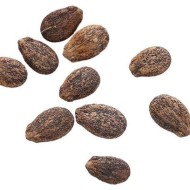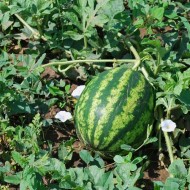The miracle of the gardener: features of planting and growing a yellow watermelon
Content
How did yellow watermelons appear?
For the first time, a yellow watermelon, or yanosik (as it is popularly called) was harvested in the Mediterranean. It is a hybrid of wild and cultivated watermelon. Today this variety is grown mainly in the southern regions.

Outwardly, the berry is very similar to its red counterpart - oval or round, green or striped peel. But the pulp differs significantly - it is yellowish or even orange. The shade depends on the climatic conditions and the air temperature at which the culture grew.
The weight of the fetus in special cases may exceed 11 kg. The hotter the climate, the more likely you are to harvest large yellow watermelons. In cold regions, their weight will fluctuate between 1-6 kg.
Video "How to grow a yellow watermelon"
In this video, you will learn how to properly grow yellow watermelons.
Popular varieties
To date, more than a dozen varieties are known, each of which has its own characteristics. The most famous are:
- A sunny gift - outside it is yellow, and inside it is orange;
- Kavbuz - a find of Ukrainian breeders who managed to give a watermelon a pumpkin flavor;
- Hamlet - Russian breeders bred a fruit with lemon pulp and pineapple flavor;
- Golden Grace - has a mild sugar taste and resistance to frost;
- Lunar - has the original taste of honey and mango, contains a lot of fructose.
Despite the fact that these varieties are considered exotic, they are rapidly gaining popularity in the countries of the post-Soviet space. This is due to the long shelf life and suitability for long-distance transportation.
Composition and useful properties
If a watermelon is yellow, this does not mean that its chemical composition will be strikingly different from fruits with red pulp. The culture is rich in fiber, glucose and fructose, vitamins A, B, C, D, antioxidants, folic acid, iron, selenium and magnesium. This variety will appeal to people who control their weight, as one slice contains only 30 kcal, 1 g of fiber and 10 g of carbohydrates.
Due to this composition, the culture has the following beneficial properties:
- strengthens the body and saturates it with vitamins;
- does not harm the health of people with gastrointestinal diseases;
- useful for the visual system;
- strengthens nails and hair;
- useful for people with blood diseases;
- fights slagging of the body;
- relieves the body of cholesterol;
- useful for pregnant women, as it prevents toxicosis;
- accelerates metabolic processes.
Agricultural machinery of yellow watermelon
In order to grow this variety, you can resort to one of several methods. The most popular is the cultivation in the garden. But you can first grow seedlings from seeds, and then transfer them to the site.
Like other melons and gourds, the yellow berry loves light and warmth. Therefore, it is necessary to take particular seriously the choice of a place for planting a culture.The plant loves moisture, so it will have to be watered often and abundantly. But do not pour, otherwise the fruits may burst.
Despite the fact that the lash is fragile and thin, it can withstand large fruits.
Seed preparation
Seeds can be purchased at any garden store or market. Before planting in the ground, they must be prepared. Experienced gardeners recommend soaking the seeds in hot water for a couple of hours. After that, they must be soaked for another hour and a half in a potassium solution. After this period of time, rinse the seeds in running water and dry.
Sowing and caring for seedlings
The most favorable time for planting seeds is mid-spring. They can also be planted in March if you have a greenhouse or greenhouse. Seeds are planted in open ground only at above-zero temperatures, when the earth is warmed up enough.
Prepare a container that you need to fill two-thirds with earth. Place the seeds, pour warm water over them and cover them with a mixture of peat and sand. Now they need to be watered with a little water. Cover the container with foil and wait until the first thin shoots appear. This process can be accelerated by using special lamps for heating seedlings.
Watering the seedlings is necessary every other day. It is important to be moderate so as not to flood the ascending sprouts. Pour the liquid around the edges of the container and gently loosen the damp soil. When three leaves appear on the seedling, the soil can be fertilized with mineral additives.
The soil should be illuminated for at least twelve hours a day. If it's cloudy outside, you can substitute the sprouts under a regular table lamp or purchase a special device.
Transplanting into the ground

Before planting the sprouts in the soil, you need to choose the right place. Find an area that is well lit by the sun and has no shadows on the south side. As for the soil, for accelerated growth, you need to opt for sandy and sandy loam soil.
Temper the soil before planting seedlings. To do this, reduce the intensity of watering a couple of days before planting. Do not forget about daily airing. You need to plant an entire earthen lump, while the soil should be moistened and warmed up. Be careful to maintain the integrity of the roots and shoots.
Growing features
For the first time after planting, the plants must be covered overnight. In this way, they can be protected against temperature extremes. In the first days, the seedlings are watered every other day, and then the number of waterings can be reduced to 1-2 times a week.
This plant does not need serious maintenance. It needs to be fed like a pumpkin crop. A week after planting in the ground, the seedlings must be fertilized with ammonium nitrate. In the future, you can feed the watermelon with superphosphates and liquid mullein.
After the ovary appears, the plant is fertilized with a mixture of potassium and phosphorus. In order to grow large berries, leave the first grown fruits, and after them pinch the whip after a couple of sheets.
Harvesting
The culture grows until mid-summer. To prevent ripe fruits from rotting, place plywood sheets under them. To make the flesh sugary, reduce or stop watering altogether. If you see that the fruit has stopped growing in size, you need to wait two weeks and then harvest. Another sign of maturity is a yellowed area of the peel in contact with the ground. Also gives out the readiness to eat the fruit shine on the peel, a dull sound when tapped and a dry tail.
Note that the fruit does not ripen after being plucked. Do not tear off the stem, it is better to cut it off. Collect the watermelons carefully so as not to hurt the skin. Store berries at 8 to 14 ° C. It is important to maintain an air humidity of about 85%.
Differences between red and yellow watermelons

The main difference between red and yellow fruit is the hue.As for the seeds, there are fewer of them in the yellow variety or they are absent altogether. The taste of the varieties also varies. Yellow is distinguished by the taste of mango and other exotic fruits. Red watermelon has a classic taste without impurities.
Yellow fruits ripen earlier. Their crust is dry and tough, so they don't make jam and candied fruits from this variety, unlike red. As for the cost, the seeds of yellow berries are more expensive.
Yellow watermelon should become a resident of the garden for all gardeners who want not only to enjoy an unusual taste, but also to receive health benefits. In addition, this culture is easy to care for, so even an amateur gardener can get large ripe fruits.



